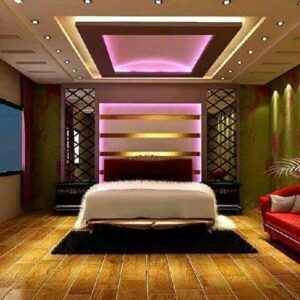As we become more conscious of our environmental impact, the concept of eco-friendly living extends beyond recycling and energy conservation to include the spaces we inhabit. Embracing eco-friendly interior design is not only a step towards reducing our carbon footprint but also an opportunity to create a harmonious and sustainable home. In this blog post, we’ll explore practical and stylish tips for incorporating eco-friendly elements into your home’s interior design.
- Choose Sustainable Materials: Opt for materials that are responsibly sourced and produced. Look for furniture made from reclaimed wood, bamboo, or recycled metal. These materials not only reduce the demand for new resources but also add a unique touch to your living space.
- Embrace Natural and Organic Fabrics: When selecting textiles for upholstery, curtains, and bedding, choose natural and organic fabrics such as organic cotton, hemp, or linen. These materials are not only gentle on the environment but also contribute to a healthier indoor air quality.
- Energy-Efficient Lighting: Replace traditional incandescent bulbs with energy-efficient LED or CFL bulbs. Consider incorporating natural lighting by strategically placing windows to maximize daylight. Additionally, use window coverings that allow you to control the amount of natural light entering your home.
- Upcycled and Vintage Decor: Embrace the charm of upcycled and vintage furniture and decor items. Not only does this add character to your home, but it also reduces the need for new manufacturing. Explore thrift stores, flea markets, and online platforms for unique finds with a history.
- Indoor Plants for Air Quality: Introduce indoor plants to your living spaces. Not only do they add a touch of nature, but they also help improve indoor air quality by filtering out pollutants. Choose low-maintenance plants like snake plants, pothos, or spider plants to effortlessly integrate greenery into your design.
- Efficient Water Use: Incorporate water-saving fixtures in bathrooms and kitchens, such as low-flow toilets and faucets. Additionally, consider collecting rainwater for watering plants or invest in water-efficient appliances to minimize water wastage.
- Chemical-Free Paints and Finishes: Traditional paints and finishes can release harmful chemicals into the air. Opt for eco-friendly, low-VOC or VOC-free paints to create a healthier indoor environment. These options are now available in a wide range of colors and finishes.
- Multi-Functional Furniture: Choose furniture pieces that serve multiple functions, such as a sofa bed or a coffee table with storage. This not only maximizes space but also reduces the need for excess furniture, promoting a minimalist and sustainable approach to interior design.
- Smart Home Technology for Energy Management: Utilize smart home technology to optimize energy usage. Smart thermostats, lighting systems, and energy-efficient appliances can be controlled remotely, allowing you to minimize energy consumption and reduce utility costs.
Creating an eco-friendly home is a journey towards a more sustainable and mindful lifestyle. By incorporating these tips into your interior design, you not only contribute to a healthier planet but also cultivate a living space that reflects your commitment to harmony with the environment. Let your home be a testament to the beauty of sustainable living, where style and eco-consciousness coexist in perfect balance.
Frequently Asked Questions: Eco-Friendly Interior Design Tips for Homes
1. Why should I consider eco-friendly interior design for my home? Eco-friendly interior design is not only beneficial for the environment but also contributes to a healthier and more sustainable lifestyle. By choosing sustainable materials, energy-efficient lighting, and eco-friendly practices, you reduce your carbon footprint and create a space that promotes well-being.
2. What are some sustainable materials for furniture and decor? Sustainable materials include reclaimed wood, bamboo, recycled metal, and FSC-certified wood. These materials are responsibly sourced, reducing the environmental impact associated with traditional manufacturing processes.
3. How can I incorporate natural lighting into my home? Maximize natural lighting by strategically placing windows to allow sunlight to flood your living spaces. Use sheer curtains or blinds to control the amount of light entering your home. This not only reduces the need for artificial lighting but also creates a bright and airy atmosphere.
4. Are there specific indoor plants that are easy to care for and improve air quality? Yes, low-maintenance indoor plants like snake plants, pothos, and spider plants are easy to care for and help improve indoor air quality. They naturally filter out pollutants and add a touch of greenery to your home.
5. Where can I find upcycled or vintage furniture for my home? Explore thrift stores, flea markets, and online platforms for unique upcycled or vintage furniture finds. These pieces often have character and history, adding a personalized touch to your home while promoting sustainable practices.
6. How can I make my home more water-efficient? Incorporate water-saving fixtures such as low-flow toilets and faucets in bathrooms and kitchens. Consider collecting rainwater for watering plants and invest in water-efficient appliances to minimize water wastage.
7. What are VOC-free paints, and why should I use them? VOC-free paints are paints with low or no volatile organic compounds (VOCs). VOCs can release harmful chemicals into the air, contributing to indoor air pollution. By choosing eco-friendly, low-VOC or VOC-free paints, you create a healthier indoor environment for you and your family.
8. How can I make my home more energy-efficient with smart home technology? Smart home technology, such as smart thermostats, lighting systems, and energy-efficient appliances, allows you to optimize energy usage. You can control these devices remotely, minimizing energy consumption and reducing utility costs.
9. What are some benefits of multi-functional furniture in eco-friendly design? Multi-functional furniture serves multiple purposes, maximizing space and reducing the need for excess furniture. This promotes a minimalist approach to interior design, which aligns with eco-friendly principles by minimizing consumption and waste.
10. Can eco-friendly interior design be stylish and aesthetically pleasing? Absolutely! Eco-friendly interior design can be both stylish and aesthetically pleasing. With the growing demand for sustainable options, there is a wide range of eco-friendly materials, colors, and designs available to suit various styles and preferences.






